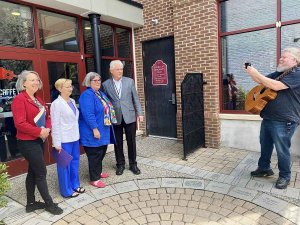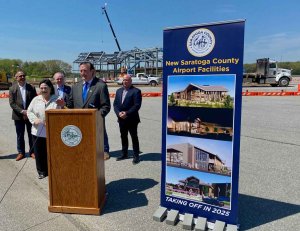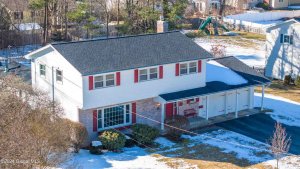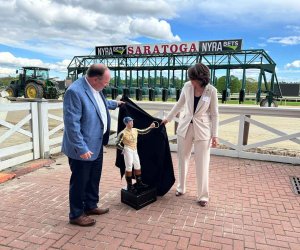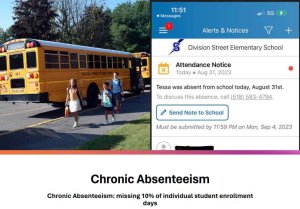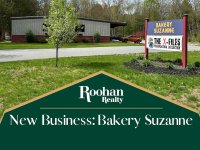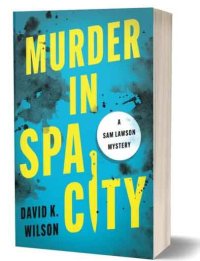On September 6, 2022, the Saratoga Springs City Council voted unanimously to send to the Planning Board a proposal from Liberty Affordable Inc. to build workforce housing on a plot of land on the corner of Crescent Avenue and Jefferson Street. This plan is very similar to the one Liberty put forward in 2018 which was unanimously rejected by the Saratoga Springs Planning Board for numerous reasons including the inability of Liberty to guarantee that only workforce housing would be built on the lot.
Now Liberty is back with a modestly revised proposal, which closely follows the 2018 plan. Their new plan involves building two structures that will hold 200 units (the 2018 proposal was for 192) that will include studios and one- and two-bedrooms apartments. According to the developer, their target population would qualify if their income range was between $45,000.00 and $84,000.00. The rents, the developer proposes, would range from $900.00 to $1,650.00 per month.
Similar to the 2018 proposal, Liberty’s selling point is that it will provide workforce housing, and similar to the 2018 proposal, actually making this housing affordable is dependent on getting federal support. The proposal will also require rezoning the parcel from RR (rural residential) to UR-4 (urban residential), a change not only in the allowed density but also in the kinds of uses permitted on the property which would be allowed whether or not the workforce project ever gets built.
At the September 6, 2022, meeting, Accounts Commissioner Dillon Moran moved that the city refer the latest version from Liberty to the Planning Board and that it makes the Council the lead agency for the State Environmental Quality Review rather than the Planning Board.
Finance Commissioner Minita Sanghvi expressed concern about the city being the lead agency in light of the fact that Commissioner Moran appeared to be sponsoring the proposal.
Mayor Kim expressed concern that the proposal probably required that the city’s Comprehensive Plan be revised before the change in zoning could be considered. The city’s comp plan currently designates the area as consistent with rural residential similar to the greenbelt although the property is not actually in the greenbelt.
A friendly amendment removed the language that would have made the Council the lead agency for now.
In light of the fact that the previous effort by Liberty resulted in a unanimous opinion opposing the project, one might have expected the current Council to ask the developer to address those earlier objections before moving the project on again so quickly to the Planning Board. That was not the case.
The Guerrilla In The Room
Whatever the reader may think about what tradeoffs the city should consider in order to expand workforce/affordable housing, there is a fundamental problem with this Liberty proposal that helped kill it in 2018 and that remains today.
In 2018, the developer was unable to provide a formal assurance that if granted the required land use regulation relief, the project would actually happen. No matter what good faith the developer may have, the project was then and is now dependent on federal and state money grants and tax incentives in order to succeed. These grants are highly competitive, and it is impossible to predict whether the principals will succeed in securing the critical money.
The city is being asked to approve the land use changes in terms of rezoning prior to knowing if the money to do the project will be forthcoming. If it is not, the land if rezoned could be used for all kinds of high-end homes and commercial uses such as hotels allowed under UR-4.
Sustainable Saratoga has a long history of advocating for affordable housing in the city. In a thoughtful letter to the City Council, though, they documented this and other problems with the proposal and asked that the Council put off action referring the project to the Planning Board “with merit” until these issues could be considered. They wrote:
Second, while Liberty may intend to apply for federal funding for affordable housing if they are granted the requested zoning amendment, there is no guarantee that they will receive such funding. If the project does not receive federal funding, the zoning change to UR-4 would allow the property to be developed in any manner permitted in that zone. By amending the zoning the city loses its ability to control development on that parcel. It cannot rescind the zoning change if the applicant fails to obtain federal funding, or make the change conditional on the developer obtaining federal funding for affordable housing. Once the parcel is rezoned, if the applicant does not receive the affordable housing grants it seeks, the parcel likely will be developed to its most financially lucrative potential within UR-4 parameters.
While I appreciate Commissioner Moran’s and the other Council members’ passionate advocacy for diverse housing as expressed at the September 6, 2022, Council meeting, it is critical that such passion be tempered by a sober and rigorous assessment of the full implications of this development proposal.
Unless Liberty can provide iron-clad proof that only affordable housing will be built, why refer this project to the Planning Board for further consideration when in the end without that guarantee it will open up yet another parcel in the city to more high end/tourist related development.
A Covenant
I’m told that one of the ways to address the issue of assuring this project would indeed produce workforce housing and not higher end housing or commercial development would be by placing a covenant on the deed that would require that only affordable housing would be allowed on the property.
If the project failed to secure funding, or should it go into bankruptcy, the owner of the property would be unable to build anything else there should such a covenant exist. The problem is affordable housing is only viable for a private for-profit developer if its construction is heavily subsidized by the government. No one is going to privately finance such a project. It is unlikely that a reasonable businessperson would put themselves in the position of owning land they potentially could not build on by agreeing to such a covenant.
Digging Into The Issues
I urge the readers of this blog to take the time to read Sustainable Saratoga’s email to the Council that is included in its entirety below. It addresses many other issues concerning the Liberty proposal and argues there are better ways to address the city’s affordable housing needs. In addition, I have included excerpts from the Planning Board meeting that considered the Liberty proposal in 2018. The comments made by members of the Planning Board are still relevant today.
Email From Sustainable Saratoga To The City Council
September 1, 2022
Dear Mayor Kim and Commissioners:
We are writing this letter to express concern about the Liberty Affordable Housing, Inc. application for a zoning amendment for a 30.27 acre parcel on the corner of Crescent Avenue and Jefferson Street.
As you may know, Sustainable Saratoga has long advocated for workforce housing in Saratoga Springs. We encourage the Council to develop a comprehensive, proactive, and creative strategy to meet the housing diversity and affordability needs of our community, and would be happy to work with the Council toward this goal. For years, Sustainable Saratoga has recommended workable alternatives, such as inclusionary zoning and the conversion of carriage houses into apartments. We also vigorously support development patterns in our city that conform to the established sustainable development principles embodied in our city’s Comprehensive Plan. We do not believe that these goals are mutually exclusive.
We have reviewed the application for a zoning amendment filed by Liberty, as well as a similar 2018 application for a zoning amendment and subsequent unfavorable advisory by the city Planning Board, and believe that the current application is flawed both procedurally and substantively. The Council should, at the outset, require the applicant to address the procedural flaws before accepting the application through a vote on “merit for review,” at least until the significant procedural errors are rectified.
There are two major procedural errors. First, the petition falsely states that the map amendment is compatible with the 2015 Comprehensive Plan. It also states that the proposed Urban Residential-4 (UR-4) zoning is consistent with the adopted Comprehensive Plan. However, page 55 of the 2015 Comprehensive Plan states that all zoning must conform to the uses and density requirements set forth in the Future Land Use Map. When areas are to be rezoned, the uses and densities permitted within the zoning district must be compatible with the ranges presented in that land use category in the Comprehensive Plan. The property is clearly designated as Residential Neighborhood-1 on page 65 of the Future Use Land Map. Such zoning allows a maximum density of 3.5 units per acre. The proposed UR-4 zoning, which has a maximum density of 14.5 units per acre, is not compatible with the Comprehensive Plan. Therefore, a request to amend the Comprehensive Plan map must accompany the application. No such request accompanied the Liberty petition.
Second, the SEQRA form attached to the rezoning petition fails to analyze the full set of uses that are permitted under UR-4 zoning. If the City Council were to rezone this 30-acre parcel to UR-4, many other uses in addition to housing would be permitted. These include private schools, hotels (20 rooms or less), lodging houses, adult care facilities, children’s homes, community centers, day care facilities, churches, social clubs, shelters, rooming houses, and other uses not permitted in the existing zone, as well as higher density residential units. The SEQRA form needs to evaluate the potential environmental impacts from the full list of uses allowed by the UR-4 zoning, not just for a housing development. The SEQRA form needs to be amended to address that omission.
Because of these two procedural errors, specifically, the failure to include a request to amend the Comprehensive Plan map and the incomplete SEQRA assessment, the application should not be advanced through a “merit for review” vote.
In addition to the procedural flaws, we also have concerns about the Liberty zoning amendment application on substantive grounds.
Our first substantive concern about the application is that the City Council does not have the authority to specify that only affordable housing can be built on the property if it is rezoned to UR-4. To try to do so would constitute “contract zoning”, which is not permitted by state law. The City Council is being asked to rezone the property, hoping that it will be developed as affordable housing but, in reality, opening this parcel to any UR-4 development. If the applicant fails to obtain federal or state funding for affordable housing or abandons the project for another reason, the UR-4 zoning would allow the applicant to sell or use the property for any of the other UR-4 uses allowed by the Unified Development Ordinance. Although a restrictive deed could perhaps restrict the property for use only as affordable housing, no such deed has been proposed by Liberty.
Second, while Liberty may intend to apply for federal funding for affordable housing if they are granted the requested zoning amendment, there is no guarantee that they will receive such funding. If the project does not receive federal funding, the zoning change to UR-4 would allow the property to be developed in any manner permitted in that zone. By amending the zoning the city loses its ability to control development on that parcel. It cannot rescind the zoning change if the applicant fails to obtain federal funding, or make the change conditional on the developer obtaining federal funding for affordable housing. Once the parcel is rezoned, if the applicant does not receive the affordable housing grants it seeks, the parcel likely will be developed to its most financially lucrative potential within UR-4 parameters.
Third, the allowable densities proposed in the amendment are inconsistent with the development of much of the surrounding area. The project parcel’s current zoning designation allows primarily for the development of low-density, single-family residential neighborhoods, applying conservation design standards. The parcel is adjacent to the city’s Greenbelt and to forested state parkland. While large multi-story apartment buildings might be appropriate in one of our downtown Transect zones, they are inappropriate on this site, which is adjacent to lower intensity development and which contains significant protected wetlands.
Finally, the Liberty application is not compatible with the city’s existing land use policy. This is a proposal for Comprehensive Plan and UDO amendments to accommodate a single incompatible use. Saratoga Springs’ current Comprehensive Plan was created through a long collaborative effort by a large committee appointed by the City Council. The planning process spanned many months and included substantial public participation. Changes to the Comprehensive Plan should only be made through the same process, involving the entire community in a comprehensive look at the future development of the entire city. Amendments to the Comprehensive Plan should be made sparingly and judiciously, and not for the purpose of promoting a single application.
Looking at the bigger picture, we strongly believe there are better ways to address the city’s affordable housing needs than the apartment complex proposed by Liberty. Large developments dedicated exclusively to “workforce housing” have the undesirable consequence of segregating the city by income, rather than integrating such housing into existing neighborhoods and new mixed-income developments. That said, we are willing to consider supporting less diverse housing projects that help address this major need but only if they are in a location that’s consistent with the Comprehensive Plan’s “city in the country” vision that is responsible for so much of this City’s success and uniqueness.
We hope the City Council will carefully review this proposal and consider the broader implications of the proposed amendments.
Thank you for considering our comments.
Sincerely,
Dianna Goodwin, Co-Chair Laura Rappaport, Co-Chair




